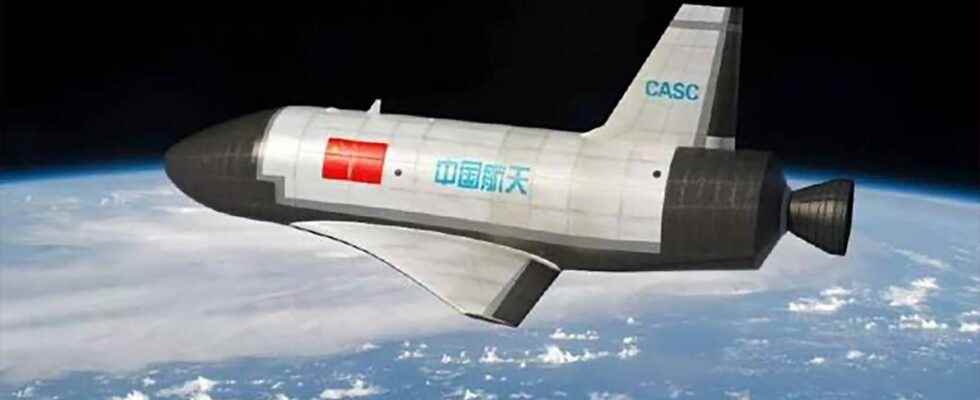You will also be interested
[EN VIDÉO] Saturn V: relive the takeoff in slow motion of the most powerful rocket in history In the 1960s, NASA developed a giant launcher called Saturn V. Objective: to put into orbit the Apollo program vehicles intended to deposit astronauts on the Moon. This archive video offers a breathtaking view of the takeoff and the first stages of the flight of this legendary launcher, the most powerful of all time. Vibrate with the thousands of spectators who attended its takeoff.
Amid heightened tensions over Nancy Pelosi’s visit to Taiwan, China has launched a mysterious reusable space vehicle. A pitcher Long March 2F took off from the Jiuquan Satellite Launch Center in the desert of Gobi, on August 4, sending a ” reusable experimental spacecraft » in orbit land bass successfully, Chinese state media reported Xinhua.
Unsurprisingly, the Chinese space authorities released no images of the launch and no details about the nature or features of the space vehicle. They also did not specify whether this is the second flight of the space vehicle which flew in September 2020 or a new vehicle, which would still be very surprising. The vehicle launched on Thursday is expected to operate in orbit for “some time” before returning to land on Chinese soil. Normally, it should remain in orbit longer than the spacecraft which flew two days in orbit in September 2020.
18e U.S. Space Force Space Defense Squadron tracked the spacecraft which is in a 346 by 593 kilometer orbit, inclined at 50 degrees.
Although little is known about the spacecraft, it is assumed, based on previous statements and activities, that it is an unmanned spaceplane that could be commissioned as soon as possible. the next years. It is assumed that this space vehicle is the Chinese answer to the US Air Force X-37B which, meanwhile, is currently performing its sixth mission with a total of more than 800 days in orbit!
China successfully tests mysterious flying spacecraft
Article of Remy Decourt published on 09/10/2020
China, which has never hidden its ambitions in the field of reusable space planes, has launched a mysterious unmanned flying spacecraft for a two-day orbital mission. This machine is obviously a precursor of an operational reusable space vehicle. But which one, because China has several confidential programs of this nature.
China has discreetly tested a reusable space drone similar to the American X-37B. The machine was launched Friday, September 4, aboard a Long March 2F launcher. After a two-day orbital flight, monitored by the United States Space Surveillance Network, it returned to land on Earth. It landed on Sunday, as quietly as it was launched, at a secret air base near the Lop Nor nuclear test range.
Unsurprisingly, no official information has been released about the launch of the spacecraft used and its mission. A press release was limited to saying that this space vehicle must be used for ” test technologies related to reusability for peaceful use of space “. It should be noted that an unusual level of security surrounded this launch so that no photos or videos of the launch and the vehicle were published on the social networks.
China successfully launched a reusable experimental spacecraft with a Long March-2F rocket from Jiuquan Satellite Launch Center Friday. The spacecraft will test reusable technologies during its flight, providing technological support for the peaceful use of space. (file pic) pic.twitter.com/h3DTlIQiD6
— China Science (@ChinaScience) September 4, 2020
Several Chinese spaceplane programs
We remember that in 2017 China declared its intention to test a reusable space vehicle in 2020 in order to have a machine with logistical and operational capabilities similar to the X-37B. The only reusable space vehicle in the world, the X-37B still arouses so much curiosity and concern due to the privacy that surrounds its missions. And the irritation of the Russians and the Chinese who suspect, rightly, the Americans of a use of the vehicle managed by the military not as scientific and peaceful as they want to say. This vehicle returned to space in May 2020 for a sixth mission.
As for this Chinese space vehicle, without any information on its main characteristics (shape, dimensions, engine, orbital capacities, etc.), we can only assume that it is a vehicle from a known space program. . It could therefore be the space version of the Shenlong orAotian space plane announced by CASC (China Aerospace Science and Technology Corporation) in November 2017. Finally, it is not excluded that this vehicle is a demonstrator of orbital flight and atmospheric re-entry, all the same quite advanced, prefiguring an operational space vehicle. To be continued then.
If you are interested in this subject, we recommend that you read Furious Dragons, Chinese space planes. Written by Philippe Coué, a French specialist in the Chinese space program, it is published by Éditions L’harmattan.
Interested in what you just read?
